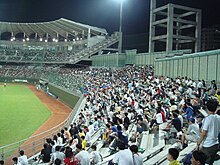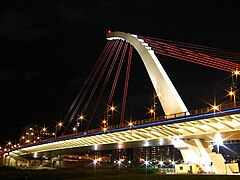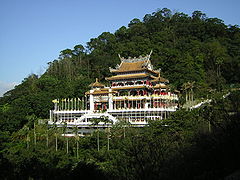Taipei
Taipei City
臺北市[I] Taihoku, Tai-pak, Taipeh | |
|---|---|
Capital city and Special municipality | |
       Clockwise from top: Taipei skyline, Presidential Office, Qixing Mountain, National Palace Museum, Bangka Lungshan Temple, Chiang Kai-shek Memorial Hall, Ximending | |
 Flag  Logo | |
| Etymology: Wade–Giles: Tʻai²-pei³; lit. 'Taiwan north' | |
| Nickname(s): The City of Azaleas | |
 | |
 | |
| Coordinates: 25°04′N 121°31′E / 25.067°N 121.517°ECoordinates: 25°04′N 121°31′E / 25.067°N 121.517°E | |
| Country | |
| Settled | 1709 |
| Seat | Xinyi District |
| Districts | show
12 |
| Government | |
| • Body |
|
| • Mayor | Ko Wen-je (TPP) |
| Area | |
| • Special municipality | 271.80 km2 (104.94 sq mi) |
| • Water | 2.7 km2 (1.0 sq mi) 1.0% |
| • Urban | 1,140 km2 (440 sq mi) |
| Area rank | 16 out of 22 |
| Population (October 2019) | |
| • Special municipality | 2,646,204 |
| • Rank | 4 out of 22 |
| • Density | 9,700/km2 (25,000/sq mi) |
| • Urban | 8,535,000 |
| • Urban density | 7,500/km2 (19,000/sq mi) |
| Time zone | UTC+8 (National Standard Time) |
| Postal code | 100–116 |
| Area code(s) | (0)2 |
| ISO 3166 code | TW-TPE |
| Bird | Formosan blue magpie (Urocissa caerulea) |
| Flower | Azalea (Rhododendron nudiflorum) |
| Tree | Banyan (India laurel fig, Ficus microcarpa) |
| Website | english |
| Taipei City | |||
|---|---|---|---|
 "Taipei" in Traditional (top) and Simplified (bottom) Chinese characters | |||
| Chinese name | |||
| Traditional Chinese | 臺北市 | ||
| Simplified Chinese | 台北市 | ||
| Literal meaning | "Tai[wan] North" | ||
| |||
| Japanese name | |||
| Kanji | 台北市 | ||
| Kana | たいほくし (1895-) タイペイし (1945-) | ||
| Kyūjitai | 臺北市 | ||
| |||
Taipei (/ˌtaɪˈpeɪ/),[4] officially Taipei City,[I] is the capital and a special municipality of Taiwan. Located in Northern Taiwan, Taipei City is an enclave of the municipality of New Taipei City that sits about 25 km (16 mi) southwest of the northern port city of Keelung. Most of the city rests on the Taipei Basin, an ancient lakebed. The basin is bounded by the relatively narrow valleys of the Keelung and Xindian rivers, which join to form the Tamsui River along the city's western border.[5]
The city of Taipei is home to an estimated population of 2,646,204 (2019),[6] forming the core part of the Taipei–Keelung metropolitan area, which includes the nearby cities of New Taipei and Keelung with a population of 7,047,559,[6][7] the 40th most-populous urban area in the world—roughly one-third of Taiwanese citizens live in the metro district. The name "Taipei" can refer either to the whole metropolitan area or just the city itself.
Taipei is the political, economic, educational and cultural center of Taiwan and one of the major hubs in East Asia. Considered to be a global city and rated as an Alpha − City by GaWC,[8] Taipei is part of a major high-tech industrial area.[9] Railways, highways, airports and bus lines connect Taipei with all parts of the island. The city is served by two airports – Songshan and Taoyuan. Taipei is home to various world-famous architectural or cultural landmarks, which include Taipei 101, Chiang Kai-shek Memorial Hall, Dalongdong Baoan Temple, Hsing Tian Kong, Lungshan Temple of Manka, National Palace Museum, Presidential Office Building, Taipei Guest House, Ximending and several night markets dispersed throughout the city. Natural features such as Maokong, Yangmingshan and hot springs are also well known to international visitors.
In English-language news reports the name Taipei often serves as a synecdoche referring to central government of Taiwan. Due to the ambiguous political status of Taiwan internationally, the term Chinese Taipei is also frequently used as a synonym for the entire country, as when Taiwan's governmental representatives participate in international organizations or Taiwan's athletes compete in international sporting events.
Etymology[]
The spellings Taipei and Tʻai-pei derive from the Wade–Giles romanization Tʻai²-pei³[10] which means the North of Taiwan in Chinese. The name could be also romanized as Táiběi according to Hanyu Pinyin and Tongyong Pinyin.[11][12][13]
The Empire of Japan acquired Taiwan in 1895 under the Treaty of Shimonoseki after the First Sino-Japanese War. Taiwan became a colony of Imperial Japan with Taihoku (formerly Taipeh-fu) as its capital.
The city has also been known as Tai-pak[14][15] (derived from Taiwanese Hokkien) and Taipeh.[16][17]
History[]

Prior to the significant influx of Han Chinese immigrants, the region of Taipei Basin was mainly inhabited by the Ketagalan plains aborigines. The number of Han immigrants gradually increased in the early 18th century under Qing Dynasty rule after the government began permitting development in the area.[18] In 1875, the northern part of the island was incorporated into the new Taipeh Prefecture.
The Qing dynasty of China made Taipeh-fu the temporary capital of the island in 1887 when it was declared a province (Fukien-Taiwan Province).[19][20] Taipeh was formally made the provincial capital in 1894. Taipei was renamed to Taihoku in 1895 when the Empire of Japan annexed Taiwan. Under Japanese rule, the city was administered under Taihoku Prefecture. Taiwan's Japanese rulers embarked on an extensive program of advanced urban planning that featured extensive railroad links. A number of Taipei landmarks and cultural institutions date from this period.[21]
Following the surrender of Japan to Allies during 1945, effective control of Taiwan was handed to the Republic of China (ROC). After losing mainland China to the Chinese Communist Party in the Chinese Civil War, the ruling Kuomintang relocated the ROC government to Taiwan and declared Taipei the provisional capital of the ROC in December 1949.[22][23][24] Taiwan's Kuomintang rulers regarded the city as the capital of Taiwan Province and their control as mandated by General Order No. 1.
In 1990, Taipei provided the backdrop for the Wild Lily student rallies that moved Taiwanese society from one-party rule to multi-party democracy by 1996. The city has ever since served as the seat of Taiwan's democratically elected national government.
First settlements[]
The region known as the Taipei Basin was home to Ketagalan tribes before the eighteenth century.[25] Han Chinese mainly from Anxi and Tong'an of Southern Fujian as well as smaller groups of Hakkas of Qing dynasty China began to settle in the Taipei Basin in 1709.[26][27]
In the late 19th century, the Taipei area, where the major Han Chinese settlements in northern Taiwan and one of the designated overseas trade ports, Tamsui, were located, gained economic importance due to the booming overseas trade, especially that of tea export. In 1875, the northern part of Taiwan was separated from Taiwan Prefecture and incorporated into the new Taipeh Prefecture as a new administrative entity of the Qing dynasty.[21] Having been established adjoining the flourishing townships of Bangka, Dalongdong, and Twatutia, the new prefectural capital was known as Chengnei (Chinese: 城內; pinyin: chéngnèi; Pe̍h-ōe-jī: siâⁿ-lāi), "the inner city", and government buildings were erected there. From 1875 until the beginning of Japanese rule in 1895, Taipei was part of Tamsui County of Taipeh Prefecture and the prefectural capital.[citation needed]
In 1885, as work commenced to govern the island as a province, Taipeh was thus temporarily designated as a provincial capital. The city officially became the capital in 1894.[citation needed] Nowadays, all that remains from the historical period is the north gate. The west gate and city walls were demolished by the Japanese while the south gate, little south gate, and east gate were extensively modified by the Kuomintang and have lost much of their original character.[28]
Empire of Japan[]

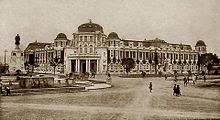
As settlement for losing the First Sino-Japanese War, China ceded the island of Taiwan to the Empire of Japan in 1895 as part of the Treaty of Shimonoseki. After the Japanese takeover, Taipei, romanized into English as Taihoku following the Japanese language pronunciation, was retained as the capital. It subsequently emerged as the political center of the Japanese Colonial Government.[21] During that time the city acquired the characteristics of an administrative center, including many new public buildings and housing for civil servants. Much of the architecture of Taipei dates from the period of Japanese rule, including the Presidential Office Building which was the Office of the Governor-General of Taiwan.
During Japanese rule, Taihoku was incorporated in 1920 as part of Taihoku Prefecture. It included Bangka, Twatutia, and Jōnai (城內) among other small settlements. The eastern village of Matsuyama (松山庄, modern-day Songshan District, Taipei) was annexed into Taihoku City in 1938. Taihoku and surrounding areas were bombed by Allied forces on several occasions. The largest of these Allied air raids, the Taihoku Air Raid, took place on 31 May 1945.
Republic of China[]


Upon the Japanese defeat in the Pacific War and its consequent surrender in August 1945, the Kuomintang (Chinese Nationalist Party) assumed control of Taiwan. Subsequently, Taipei was established as a provincial city and a temporary Office of the Taiwan Province Administrative Governor was established in it.[29] In 1947 the Kuomintang (KMT) government under Chiang Kai-shek declared island-wide martial law in Taiwan as a result of the 28 February Incident, which began with incidents in Taipei but led to an island-wide crackdown on the local population by forces loyal to Chiang. Two years later, on 7 December 1949, Chiang and the Kuomintang forces were forced to flee mainland China by the Communists near the end of the Chinese Civil War. The KMT-led national government that fled to Taiwan declared Taipei to be the provisional capital of a continuing Republic of China, with the official capital at Nanjing (Nanking) even though that city was under Communist control.[22][23]
Taipei expanded greatly in the decades after 1949, and as approved on 30 December 1966, by the Executive Yuan, Taipei was declared a special municipality on 1 July 1967.[27] In the following year, Taipei City expanded again by annexing Shilin, Beitou, Neihu, Nangang, Jingmei, and Muzha. At that time, the city's total area increased fourfold by absorbing several outlying towns and villages and the population increased to 1.56 million people.[27]
The city's population, which had reached one million in the early 1960s, also expanded rapidly after 1967, exceeding two million by the mid-1970s. Although growth within the city itself gradually slowed thereafter[29] — its population had become relatively stable by the mid-1990s – Taipei remained one of the world's most densely populated urban areas, and the population continued to increase in the region surrounding the city, notably along the corridor between Taipei and Keelung.
In 1990 Taipei's 16 districts were consolidated into the current 12 districts.[30] Mass democracy rallies that year in the plaza around Chiang Kai-shek Memorial Hall led to an island-wide transition to multi-party democracy, where legislators are chosen via regularly scheduled popular elections, during the presidency of Lee Teng-Hui.
Geography[]

Taipei City is located in the Taipei Basin in northern Taiwan.[31] It is bordered by the Xindian River on the south and the Tamsui River on the west. The generally low-lying terrain of the central areas on the western side of the municipality slopes upward to the south and east and especially to the north,[5] where it reaches the 1,120-meter (3,670 ft)-tall Qixing Mountain, the highest (inactive) volcano in Taiwan in Yangmingshan National Park. The northern districts of Shilin and Beitou extend north of the Keelung River and are bordered by Yangmingshan National Park. The Taipei city limits cover an area of 271.7997 km2 (104.9425 sq mi),[32] ranking sixteenth of twenty-five among all counties and cities in Taiwan.
Two peaks, Qixing Mountain and Mt. Datun, rise to the northeast of the city.[33] Qixing Mountain is located on the Tatun Volcano Group; its 1,120-meter (3,670 ft)-high main peak renders it the tallest mountain at the rim of the Taipei Basin; 1,092-meter (3,583 ft)-high Mt. Datun is a close runner up. These former volcanoes make up the western section of Yangmingshan National Park, extending from Mt. Datun northward to Mt. Caigongkeng (菜公坑山). Located on a broad saddle between two mountains, the area also contains the marshy Datun Pond.
To the southeast of the city lie the Songshan Hills and the Qingshui Ravine, which form a barrier of lush woods.[33]
Climate[]
| Taipei | ||||||||||||||||||||||||||||||||||||||||||||||||
|---|---|---|---|---|---|---|---|---|---|---|---|---|---|---|---|---|---|---|---|---|---|---|---|---|---|---|---|---|---|---|---|---|---|---|---|---|---|---|---|---|---|---|---|---|---|---|---|---|
| Climate chart (explanation) | ||||||||||||||||||||||||||||||||||||||||||||||||
| ||||||||||||||||||||||||||||||||||||||||||||||||
| ||||||||||||||||||||||||||||||||||||||||||||||||
Taipei has a humid subtropical climate[34][35][36] (Köppen: Cfa).[37] Summers are long-lasting, very hot and humid, and accompanied by occasional heavy rainstorms and typhoons; while winters are short, generally warm and generally very foggy due to the northeasterly winds from the vast Siberian High being intensified by the pooling of this cooler air in the Taipei Basin. As in the rest of Northern Taiwan, daytime temperatures of Taipei can often peak above 26 °C (79 °F) during a warm winter day, while they can dip below that same level during a rainy summer's afternoon. Occasional cold fronts during the winter months can drop the daily temperature by 3 to 5 °C (5.4 to 9.0 °F), though temperatures rarely drop below 10 °C (50 °F).[38] Extreme temperatures ranged from −0.2 °C (31.6 °F) on 13 February 1901 to 39.7 °C (103.5 °F) on 24 July 2020, while snow has never been recorded in the city besides on mountains located within the city limit such as Yangmingshan. Due to Taiwan's location in the Pacific Ocean, it is affected by the Pacific typhoon season, which occurs between June and October.
| showClimate data for Taipei (normals 1991–2020, extremes 1896–present) |
|---|
Air quality[]
In comparison to other Asian cities, Taipei has "excellent" capabilities for managing air quality in the city.[40] Its rainy climate, location near the coast, and strong environmental regulations have prevented air pollution from becoming a substantial health issue, at least compared to cities in southeast Asia and industrial China. However, smog is extremely common and there is poor visibility throughout the city after rainless days.
Motor vehicle engine exhaust, particularly from motor scooters, is a source of air pollution in Taipei. There are higher levels of fine particulate matter and polycyclic aromatic hydrocarbons in the mornings because of less air movement; sunlight reduces some pollution.[41]
Cityscape[]
Demographics[]
| Year | Pop. | ±% |
|---|---|---|
| 1985 | 2,507,620 | — |
| 1990 | 2,719,659 | +8.5% |
| 1995 | 2,632,863 | −3.2% |
| 2000 | 2,646,474 | +0.5% |
| 2005 | 2,632,242 | −0.5% |
| 2010 | 2,618,772 | −0.5% |
| 2015 | 2,704,810 | +3.3% |
| Source:"Populations by city and country in Taiwan". Ministry of the Interior Population Census. | ||

While Taipei City is home to 2,704,810 people (2015), the greater metropolitan area has a population of 7,047,559 people.[6] Even though the population of the city has been decreasing in recent years, the population of adjacent New Taipei has been increasing. The population loss, while rapid in its early years, has been stabilized by new lower density development and campaigns designed to increase the birthrate in the city. As a result, the population has begun to rise again since 2010.[6][42][43]
Due to Taipei's geography and location in the Taipei Basin as well as differing times of settlement and differing degrees of economic development of its districts, Taipei's population is not evenly distributed. The districts of Daan, Songshan, and Datong are the most densely populated. These districts, along with adjacent communities such as Yonghe and Zhonghe, contain some of the most densely populated neighborhoods in the world.[42]
In 2008, the crude birth rate stood at 7.88%, while the mortality rate stood at 5.94%. A decreasing and rapidly aging population is an important issue for the city.[42] By the end of 2009, one in ten people in Taipei was over 65 years of age.[44] Residents who had obtained a college education or higher accounted for 43.48% of the population, and the literacy rate stood at 99.18%.[42]
Like the rest of Taiwan, Taipei is composed of four major ethnic groups: Hoklos, Mainlanders, Hakkas, and aborigines.[42] Although Hoklos and Mainlanders form the majority of the population of the city, in recent decades many Hakkas have moved into the city. The aboriginal population in the city stands at 16,713 at the end of 2018 (<1%), concentrated mostly in the suburban districts. Foreigners (mainly from Indonesia, the Philippines, and Japan) numbered 69,982 at the end of 2019.[42][45]
| Age Distribution | Male | Female |
|---|---|---|
| 0–4 | 73680 | 69574 |
| 5–9 | 57701 | 53004 |
| 10–14 | 67345 | 61491 |
| 15–19 | 77974 | 72110 |
| 20–24 | 78552 | 73103 |
| 25–29 | 78447 | 80882 |
| 30–34 | 105245 | 118719 |
| 35–39 | 107951 | 123852 |
| 40–44 | 96222 | 111729 |
| 45–49 | 96535 | 112049 |
| 50–54 | 98411 | 112322 |
| 55–59 | 96092 | 110635 |
| 60–64 | 87691 | 100472 |
| 65–69 | 55867 | 64949 |
| 70–74 | 40087 | 50018 |
| 75–79 | 28413 | 39123 |
| 80–84 | 23314 | 26760 |
| 85+ | 26109 | 25887 |
Economy[]



As Taiwan's business, financial, and technology hub, Taipei has been at the center of rapid economic development in the country and has now become one of the global cities in technology and electronics.[46] This development is part of the so-called Taiwan Miracle which has seen dramatic growth in the city following foreign direct investment in the 1960s. Taiwan is now a creditor economy, holding one of the world's largest foreign exchange reserves of over US$403 billion as of December 2012.[47]
Despite the Asian financial crisis, the economy continues to expand at about 5% per year, with virtually full employment and low inflation. The city's GDP stand at US$327 billion in 2014.[48] As of 2013, the nominal GDP per capita in Taipei city is 5th highest in East Asia, behind Tokyo, Singapore, Osaka, and Hong Kong, but ahead of Seoul, as well as London and Paris, according to The Economist.[49] GDP per capita based on Purchasing Power Parity (PPP) in Taipei in 2015 was US$44173, behind that of Singapore (US$90151 in 2016 from the IMF) and Hong Kong (US$58322 in 2016 from the IMF; also based on PPP).[50] The Financial Times ranked Taipei highly in economic potential (2nd, behind Tokyo) and business friendliness (4th) in 2015.[51] The city is home to 30 billionaires, the 16th most in the world, ahead of many global cities such as Los Angeles and Sydney.[52] Business Insider also ranks Taipei the 5th most high-tech city globally, the highest in Asia, in 2017.[53] While the IESE Cities in Motion Index 2017 ranks Taipei as the smartest technology city globally.[54]
Taipei's main development fields include the information and communications technology (hardware and software), biotechnology, general merchandizing (wholesale/retail), financial services, and MICE industries. Most of the country's major firms are based there including Acer Computers, Asus, CTBC Bank, Fubon Financial Holding, Tatung Company, D-Link, and others. 5 Global Fortune 500 companies are headquartered in Taipei.[55] The city also attracts many multi-national corporations, international financial institutions, foreign consulates, and business organizations to set up base there. Thus, Taipei has nearly 3,500 registered foreign businesses and attracts over 50% of the total foreign investment in Taiwan.[56] Foreign companies with offices or regional headquarters in Taipei include Google, Microsoft, IBM, Intel, HSBC, Citibank, Facebook, Amazon, Apple, JP Morgan, PwC, and many others. Most financial and foreign firms like to reside in the central business district of Taipei, the Xinyi Special District. With Citi, JP Morgan, DBS Bank, Cathay Life Insurance, Shin Kong Commercial Bank, Hua Nan Bank, and soon Fubon Financial and Nan Shan Life Insurance all establishing skyscrapers in the area. Meanwhile, technology and electronics companies are often co-located in the or the Nankang Software Park. The startup and innovation scene in Taipei is also very vibrant. In 2018 alone, Microsoft announced plans to invest US$34 million to create an artificial intelligence R&D center in Taipei, while Google announced it will hire 300 people and train 5,000 more in artificial intelligence for machines.[57] Taipei is Google's biggest engineering site in Asia.[58] IBM also announced in 2018 that it will develop a cloud research lab and expand its R&D center in Taipei with eyes on artificial intelligence, blockchain technology, and cloud computing. According to the 2016 Global Entrepreneurship Development Index, Taipei's entrepreneurial spirit ranks 6th worldwide and 1st in Asia.[59] Taipei has more than 400 startups and numerous incubation centers, accelerators, venture capitals, and angel investors.[60] The city's startup ecosystem is valued at US$580 million by Startup Genome in 2018.[61]
Tourism is a small but significant component of the local economy[62][63] with international visitors totaling almost 3 million in 2008.[64] Taipei has many top tourist attractions and contributes a significant amount to the US$6.8 billion tourism industry in Taiwan.[65]
Culture[]
Tourism[]
Tourism is a major part of Taipei's economy. In 2013, over 6.3 million overseas visitors visited Taipei, making the city the 15th most visited globally.[66] The influx of visitors contributed US$10.8 billion to the city's economy in 2013, the 9th highest in the world and the most of any city in the Chinese-speaking world.[67]
Commemorative sites and museums[]
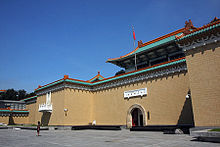



The National Chiang Kai-shek Memorial Hall is a famous monument, landmark and tourist attraction that was erected in memory of General Chiang Kai-shek, former President of the Republic of China.[68] The structure stands at the east end of Memorial Hall Square, site of the National Concert Hall and National Theater and their adjacent parks as well as the memorial. The landmarks of Liberty Square stand within sight of Taiwan's Presidential Office Building in Taipei's Zhongzheng District.

The National Taiwan Museum sits nearby in what is now 228 Peace Memorial Park and has worn its present name since 1999. The museum is Taiwan's oldest, founded on 24 October 1908 by Taiwan's Japanese colonial government (1895-1945) as the Taiwan Governor's Museum. It was launched with a collection of 10,000 items to celebrate the opening of the island's North-South Railway.[69] In 1915 a new museum building opened its doors in what is now 228 Peace Memorial Park. This structure and the adjacent governor's office (now Presidential Office Building), served as the two most recognizable public buildings in Taiwan during its period of Japanese rule.[69]
The National Palace Museum is a vast art gallery and museum built around a permanent collection centered on ancient Chinese artifacts. It should not be confused with the Palace Museum in Beijing (which it is named after); both institutions trace their origins to the same institution. The collections were divided in the 1940s as a result of the Chinese Civil War.[70][71] The National Palace Museum in Taipei now boasts a truly international collection while housing one of the world's largest collections of artifacts from ancient China.[71]
The Shung Ye Museum of Formosan Aborigines stands just 200 meters (660 ft) across the road from the National Palace Museum. The museum offers displays of art and historical items by Taiwanese aborigines along with a range of multimedia displays.
The Taipei Fine Arts Museum was established in 1983 as the first museum in Taiwan dedicated to modern art. The museum is housed in a building designed for the purpose that takes inspiration from Japanese designs. Most art in the collection is by Taiwanese artists since 1940. Over 3,000 art works are organized into 13 groups.
The National Sun Yat-sen Memorial Hall near Taipei 101 in Xinyi District is named in honor of a founding father of the Republic of China, Sun Yat-sen. The hall, completed on 16 May 1972, originally featured exhibits that depicted revolutionary events in China at the end of the Qing Dynasty. Today it functions as multi-purpose social, educational, concert and cultural center for Taiwan's citizens.[72]

In 2001 a new museum opened as Museum of Contemporary Art Taipei. The museum is housed in a building that formerly housed Taipei City government offices.[73]
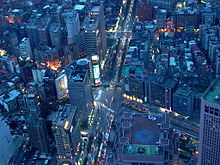
Taipei 101[]
Taipei 101 is a 101-floor landmark skyscraper that claimed the title of world's tallest building when it opened in 2004, a title it held for six years before relinquishing it to the Burj Khalifa in Dubai. Designed by C.Y. Lee & Partners and constructed by KTRT Joint Venture, Taipei 101 measures 508 m (1,667 ft) from ground to top, making it the first skyscraper in the world to break the half-kilometer mark in height. Built to withstand typhoon winds and earthquake tremors, its design incorporates many engineering innovations and has won numerous international awards. Taipei 101 remains one of the tallest skyscrapers in the world and holds LEED's certification as the world's largest "green" building. Its shopping mall and its indoor and outdoor observatories draw visitors from all over the world. Taipei 101's New Year's Eve fireworks display is a regular feature of international broadcasts.
Performing arts[]
The National Theater and Concert Hall stand at Taipei's Liberty Square and host events by foreign and domestic performers. Other leading concert venues include Zhongshan Hall at Ximending and the Sun Yat-sen Memorial Hall near Taipei 101.
A new venue, the Taipei Performing Arts Center, is under construction and slated to open in 2015.[74][75] The venue will stand near the Shilin Night Market[76] and will house three theaters for events with multi-week runs. The architectural design, by Rem Koolhaas and OMA, was determined in 2009 in an international competition.[77] The same design process is also in place for a new Taipei Center for Popular Music and Taipei City Museum.[78]
Shopping and recreation[]
Taipei is known for its many night markets, the most famous of which is the Shilin Night Market in the Shilin District. The surrounding streets by Shilin Night Market are extremely crowded during the evening, usually opening late afternoon and operating well past midnight. Most night markets feature individual stalls selling a mixture of food, clothing, and consumer goods.

Ximending has been a famous area for shopping and entertainment since the 1930s. Historic structures include a concert hall, a historic cinema, and the Red House Theater. Modern structures house karaoke businesses, art film cinemas, wide-release movie cinemas, electronic stores, and a wide variety of restaurants and fashion clothing stores.[79] The pedestrian area is especially popular with teens and has been called the "Harajuku" of Taipei.[80]
The newly developed Xinyi District is popular with tourists and locals alike for its many entertainment and shopping venues, as well as being the home of Taipei 101, a prime tourist attraction. Malls in the area include the sprawling Shin Kong Mitsukoshi complex, Breeze Center, Bellavita, Taipei 101 mall, Eslite Bookstore's flagship store (which includes a boutique mall), The Living Mall, ATT shopping mall, and the Vieshow Cinemas (formerly known as Warner Village). The Xinyi district also serves as the center of Taipei's active nightlife, with several popular lounge bars and nightclubs concentrated in a relatively small area around the Neo19, ATT 4 FUN and Taipei 101 buildings. Lounge bars such as Barcode and nightclubs such as Spark and Myst are among the most-visited places here.
The thriving shopping area around Taipei Main Station includes the Taipei Underground Market and the original Shin Kong Mitsukoshi department store at Shin Kong Life Tower. Other popular shopping destinations include the Zhongshan Metro Mall, Dihua Street and the Guang Hua Digital Plaza. The Miramar Entertainment Park is known for its large Ferris wheel and IMAX theater.
Taipei maintains an extensive system of parks, green spaces, and nature preserves. Parks and forestry areas of note in and around the city include Yangmingshan National Park, Taipei Zoo and Da-an Forest Park. Located 10 kilometers (6.2 mi) north of the city center, Yangmingshan National Park is famous for its cherry blossoms, hot springs, and sulfur deposits. It is the home of famous writer Lin Yutang, the summer residence of Chiang Kai-shek, residences of foreign diplomats, the Chinese Culture University, the meeting place of the now defunct National Assembly of the Republic of China, and the Kuomintang Party Archives. The Taipei Zoo was founded in 1914 and covers an area of 165 hectares for animal sanctuary.
Bitan is known for boating and water sports. Tamsui is a popular sea-side resort town. Ocean beaches are accessible in several directions from Taipei.
Temples[]

Taipei has a variety of temples dedicating to Deities from Chinese folk religion, Taoism and Chinese Buddhism. The Bangka Lungshan Temple (艋舺龍山寺), built in 1738 and located in the Wanhua District, demonstrates an example of architecture with southern Chinese influences commonly seen on older buildings in Taiwan. Qingshui Temple (艋舺清水巖) built in 1787 and Qingshan Temple (艋舺青山宮)together with Lungshan Temple are the three most prominent landmark temples in Bangka or Wanhua District.
There are other famous temples include Baoan Temple (大龍峒保安宮) located in historic Dalongdong, a national historical site, and Xia Hai City God Temple (大稻埕霞海城隍廟), located in the old Dadaocheng community, constructed with architecture similar to temples in southern Fujian.[81] The Taipei Confucius Temple (臺北孔子廟) traces its history back to 1879 during the Qing Dynasty and also incorporates southern Fujian-style architecture.[82] Ciyou Temple (松山慈祐宮) in Songshan District, Guandu Temple (關渡宮) in Beitou District, Hsing Tian Kong (行天宮) in Zhongshan District and Zhinan Temple (指南宮) in Wenshan District are also popular temples for locals and tourists. Xinsheng South Road is known as the "Road to Heaven" due to its high concentration of temples, churches, and other houses of worship.[83][84]
The Shandao Temple (善導寺) built in 1929 and located in Zhongzheng District, is the largest Buddhist temple in Taipei. Fo Guang Shan has a modern temple known as Fo Guang Shan Taipei Vihara (佛光山臺北道場) in Xinyi District, while Dharma Drum Mountain owns the Degui Academy (德貴學苑), an education center in Zhongzheng District and the Nung Chan Monastery (農禪寺) in Beitou District. Linji Huguo Chan Temple (臨濟護國禪寺) in Zhongshan District was commenced in 1900 and completed in 1911, it is one of the very few Japanese style Buddhist Temples that was well-preserved in Taiwan.
Besides large temples, small outdoor shrines to local deities are very common and are commonly found next to roads as well as in parks and neighborhoods. Many homes and businesses may also set up small shrines of candles, figurines, and offerings. Some restaurants, for example, may set up a small shrine to the Kitchen God for success in a restaurant business.[85]
Festivals and events[]
Many yearly festivals are held in Taipei. In recent years some festivals, such as the Double Ten Day fireworks and concerts, are increasingly hosted on a rotating basis by a number of cities around Taiwan.
When New Year's Eve arrives on the solar calendar, thousands of people converge on Taipei's Xinyi District for parades, outdoor concerts by popular artists, street shows, round-the clock nightlife. The high point is the countdown to midnight, when Taipei 101 assumes the role of the world's largest fireworks platform.[citation needed]
The Taipei Lantern Festival concludes the Lunar New Year holiday. The timing of the city's lantern exhibit coincides with the national festival in Pingxi, when thousands of fire lanterns are released into the sky.[86] The city's lantern exhibit rotates among different downtown locales from year to year, including Liberty Square, Taipei 101, and Zhongshan Hall in Ximending.
On Double Ten Day, patriotic celebrations are held in front of the Presidential Office Building. Other annual festivals include Ancestors Day (Tomb-Sweeping Day), the Dragon Boat Festival, the Zhong Yuan Festival, and the Mid-Autumn Festival (Mooncake Festival).[86] Qing Shan King Sacrificial Ceremony (青山王祭) is a century-old grand festival that is held annually in Wanhua District.
Taipei regularly hosts its share of international events. The city recently hosted the 2009 Summer Deaflympics.[87] This event was followed by the Taipei International Flora Exposition, a garden festival hosted from November 2010 to April 2011. The Floral Expo was the first of its kind to take place in Taiwan and only the seventh hosted in Asia; the expo admitted 110,000 visitors on 27 February 2011.
Taipei in films[]
This section contains embedded lists that may be poorly defined, unverified or indiscriminate. (December 2018) |
Note: The list below is not a complete list, they are examples of more notable movies filmed in the city.
- Luc Besson's Lucy (action/scifi/drama)
- Arvin Chen's Au Revoir Taipei (comedy)
- Chen Kuo-fu's Double Vision (horror/suspense)
- Chen Kuo-fu's The Personals (drama/romance)
- Jay Chou's Secret (romance)
- Leon Dai's No Puedo Vivir Sin Ti (drama)
- Hou Hsiao-hsien's Dust in the Wind (drama)
- Adam Kane and Will Tiao's Formosa Betrayed (political thriller)
- Andrew Lau's Young and Dangerous 2 (Hong Kong studio, filmed on location in Taipei)
- Lau Kar-wing's The Dragon Family (Hong Kong studio, filmed in Hong Kong and Taipei) (Action)[citation needed]
- Ang Lee's Eat Drink Man Woman (drama)
- Lin Cheng-sheng's Betelnut beauty (drama/romance)
- Morgan Matthews's X+Y (drama)
- Doze Niu's Monga (drama/action)
- Shimoyama Ten, Yee Chin-yen & Zhang Yibai's About Love (Japanese studio, filmed on three cities in Asia: Taipei, Tokyo, and Shanghai)
- Takahisa Zeze's Moon Child (Japanese studio, filmed in Taipei, as the futuristic city of Mallepa) (drama)
- Johnnie To & Wai Ka-Fai's Turn Left, Turn Right (Hong Kong studio, filmed on location in Taipei)
- Tsai Ming-liang's Rebels of the Neon God (drama)
- Renpei Tsukamoto's One Missed Call 2 (Japanese studio, filmed in Taipei and Jinguashi)[citation needed]
- Wei Te-sheng's Cape No. 7 (drama/comedy)
- Robert Wise's The Sand Pebbles (Hollywood studio, filmed in Taipei, Keelung, Tamsui and Hong Kong) (drama)
- John Woo's A Better Tomorrow (Hong Kong studio, filmed in Hong Kong and Taipei) (action)
- Wong Kar-wai's Happy Together (Hong Kong studio, filmed in three cities : Buenos Aires, Hong Kong, and Taipei)
- Kirk Wong's Crime Story (Hong Kong studio, filmed in Hong Kong, Taipei) (action)
- Edward Yang's Yi Yi (drama)
- Yee Chin-yen's Blue Gate Crossing (romance)
Government[]


Taipei City is a special municipality which is directly under the Executive Yuan (Central Government). The mayor of Taipei City was an appointed position since Taipei's conversion to a centrally administered municipality in 1967 until the first public election was held in 1994.[88] The position has a four-year term and is elected by direct popular vote. The first elected mayor was Chen Shui-bian of the Democratic Progressive Party. Ma Ying-jeou took office in 1998 for two terms, before handing it over to Hau Lung-pin who won the 2006 mayoral election on 9 December 2006.[89] Both Chen Shui-bian and Ma Ying-Jeou went on to become President of the Republic of China. The incumbent mayor, Ko Wen-je, was elected on 29 November 2014 and took office on 25 December 2014.[90]
Based on the outcomes of previous elections in the past decade, the vote of the overall constituency of Taipei City shows a slight inclination towards the pro-KMT camp (the Pan-Blue Coalition);[91] however, the pro-DPP camp (the Pan-Green Coalition) also has considerable support.[92]
Ketagalan Boulevard, where the Presidential Office Building and other government structures are situated, is often the site of mass gatherings such as inauguration and national holiday parades, receptions for visiting dignitaries, political demonstrations,[93][94] and public festivals.[95]
Garbage recycling[]
Taipei City is also famous for its effort in garbage recycling, which has become such a good international precedent that other countries have sent teams to study the recycling system. After the Environmental Protection Administration (EPA) established a program in 1998 combining the efforts of communities, a financial resource named the Recycling Fund was made available to recycling companies and waste collectors. The EPA also introduced garbage recycling trucks, in effort to raise community recycling awareness, that broadcast classical music (specifically Beethoven's "Für Elise" and Tekla Bądarzewska-Baranowska's "A Maiden’s Prayer") to announce its arrival to the community.[96] Manufacturers, vendors and importers of recyclable waste pay fees to the Fund, which uses the money to set firm prices for recyclables and subsidize local recycling efforts. Between 1998 and 2008, the recycling rate increased from 6 percent to 32 percent.[97] This improvement enabled the government of Taipei to demonstrate its recycling system to the world at the Shanghai World Expo 2010.
Administrative divisions[]
Taipei City is divided up into 12 administrative districts (區; qū).[98] Each district is further divided up into urban villages (里), which are further sub-divided up into neighborhoods (鄰). Xinyi District is the seat of the municipality where the Taipei City Government headquarters is located.
| Map | District | Population (Jan. 2016) |
Area (km2) |
Postal code | ||||
|---|---|---|---|---|---|---|---|---|
| Name[99] | Chinese[100] | Pinyin | Wade–Giles | Pe̍h-ōe-jī | ||||
| Beitou | 北投區 | Běitóu | Pei-t'ou | Pak-tâu | 257,922 | 56.8216 | 112 | |
| Daan (Da-an, Da'an) | 大安區 | Dà'ān | Ta-an | Tāi-an | 312,909 | 11.3614 | 106 | |
| Datong | 大同區 | Dàtóng | Ta-t'ung | Tāi-tông | 131,029 | 5.6815 | 103 | |
| Nangang (Nankang) | 南港區 | Nángǎng | Nan-kang | Lâm-káng | 122,296 | 21.8424 | 115 | |
| Neihu | 內湖區 | Nèihú | Nei-hu | Lāi-ô͘ | 287,726 | 31.5787 | 114 | |
| Shilin | 士林區 | Shìlín | Shih-lin | Sū-lîm | 290,682 | 62.3682 | 111 | |
| Songshan | 松山區 | Sōngshān | Sung-shan | Siông-san | 209,689 | 9.2878 | 105 | |
| Wanhua | 萬華區 | Wànhuá | Wan-hua | Báng-kah | 194,314 | 8.8522 | 108 | |
| Wenshan | 文山區 | Wénshān | Wen-shan | Bûn-san | 275,433 | 31.5090 | 116 | |
| Xinyi | 信義區 | Xìnyì | Hsin-yi | Sìn-gī | 229,139 | 11.2077 | 110 | |
| Zhongshan | 中山區 | Zhōngshān | Chung-shan | Tiong-san | 231,286 | 13.6821 | 104 | |
| Zhongzheng | 中正區 | Zhōngzhèng | Chung-cheng | Tiong-chèng | 162,549 | 7.6071 | 100 | |
City planning[]
The city is characterized by straight roads and public buildings of grand Western architectural styles.[101] The city is built on a square grid configuration; however, these blocks are huge by international standards with 500 m (1,640.42 ft) sides. The area in between these blocks is infilled with lanes and alleys, which provide access to quieter residential or mixed-use development. Other than a citywide 30 km/h (19 mph) speed limit, there is little uniform planning within this "hidden" area; therefore, lanes (perpendicular to streets) and alleys (parallel with streets, or, conceptually, perpendicular to lanes) spill out from the main controlled-access highways. These minor roads are not always perpendicular and sometimes cut through the block diagonally.
Although development began in the western districts of the city (still considered the cultural heart of Taipei) due to trade, the eastern districts have become the focus of recent development projects. Many of the western districts, already in decline, have become targets of urban renewal initiatives.[101]
Transportation[]

Public transport accounts for a substantial portion of different modes of transport in Taiwan, with Taipei residents having the highest utilization rate at 34.1%.[102] Private transport consists of motor scooters, private cars, taxi cabs, and bicycles. Motor-scooters often weave between cars and occasionally through oncoming traffic. Respect for traffic laws, once scant, has improved with deployment of traffic cameras and increasing numbers of police roadblocks checking riders for alcohol consumption and other offenses.
Taipei Station serves as the comprehensive hub for the subway, bus, conventional rail, and high-speed rail.[103] A contactless smartcard, known as EasyCard, can be used for all modes of public transit as well as several retail outlets. It contains credits that are deducted each time a ride is taken.[104] The EasyCard is read via MIFARE panels on buses and in MRT stations, and it does not need to be removed from one's wallet or purse.
Metro[]
Taipei's public transport system, the Taipei Metro (commonly referred to as the MRT), incorporates a metro and light rail system based on advanced VAL and Bombardier technology. There are currently six metro lines that are organized and labeled in three ways: by color, line number and depot station name. In addition to the rapid transit system itself, the Taipei Metro also includes several public facilities such as the Maokong Gondola, underground shopping malls, parks, and public squares. Modifications to existing railway lines to integrate them into the metro system are underway.
In 2017 a rapid transit line was opened to connect Taipei with Taiwan Taoyuan International Airport and Taoyuan City. The new line is part of the new Taoyuan Metro system.
On 31 January 2020, Hitachi Rail Corporation officially commissioned Phase 1 of the Circular Line which took place at Shisizhang Station. The Circular Line is a 15.4 km driverless rail system. The Circular line offered free rides beginning in February 2020 for passengers to test the route.[105][106]

Rail[]
Beginning in 1983, surface rail lines in the city were moved underground as part of the Taipei Railway Underground Project.[107] The Taiwan High Speed Rail system opened in 2007. The bullet trains connect Taipei with the west coast cities of New Taipei, Taoyuan, Hsinchu, Taichung, Chiayi, and Tainan before terminating at Zuoying (Kaohsiung) at speeds that cut travel times by 60% or more from what they normally are on a bus or conventional train.[108] The Taiwan Railways Administration also runs passenger and freight services throughout the entire island.
Bus[]
An extensive city bus system serves metropolitan areas not covered by the metro, with exclusive bus lanes to facilitate transportation.[103] Riders of the city metro system are able to use the EasyCard for discounted fares on buses, and vice versa. A unique feature of the Taipei bus system is the joint venture of private transportation companies that operate the system's routes while sharing the fare system. This route is in sharp contrast to bus systems in the U.S. which are mostly public entities. Several major intercity bus terminals are located throughout the city, including the Taipei Bus Station and Taipei City Hall Bus Station.[109]
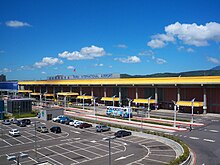
Airports[]
Most scheduled international flights are served by Taoyuan International Airport in nearby Taoyuan City. Taipei Songshan Airport, at the heart of the city in the Songshan District, serves domestic flights and scheduled flights to Haneda Airport in Tokyo, Gimpo International Airport in Seoul, and about 15 destinations in the People's Republic of China. Songshan Airport is accessible by the Taipei Metro Neihu Line; Taoyuan International Airport is accessible by the Taoyuan Airport MRT.
Ticketing[]
In 1994, following the rapid development of Taipei, a white paper for transport policies expressed the strong objective of creating a transport system for the people of Taipei to accommodate the burgeoning city's needs. In 1999, they chose Mitac consortium, which Thales-Transportation Systems is part of. Thales was then selected again in 2005 to deploy an upgrade of Taipei's public transport network with an end-to-end and fully contactless automatic fare collection solution that integrates 116 metro stations, 5,000 buses and 92 car parks.[citation needed]
Education[]

Taipei is home to the campuses of 24 universities and Academia Sinica, Taiwan's national academy which supports the Taiwan International Graduate Program:
|
|
National Taiwan University (NTU or Tai-Da) was established in 1928 during the period of Japanese colonial rule. NTU has produced many political and social leaders in Taiwan. Both pan-blue and pan-green movements in Taiwan are rooted on the NTU campus. The university has six campuses in the greater Taipei region (including New Taipei) and two additional campuses in Nantou County. The university governs farms, forests, and hospitals for educational and research purposes. The main campus is in Taipei's Da-An district, where most department buildings and all the administrative buildings are located. The College of Law and the College of Medicine are located near the Presidential Office Building. The National Taiwan University Hospital is a leading international center of medical research.[110]
National Taiwan Normal University (NTNU or Shi-Da) likewise traces its origins to the Japanese colonial period. Founded as Taihoku College in 1922 and organized as a teacher training institution by the Kuomintang in 1946, NTNU has since developed into a comprehensive international university. The university boasts especially strong programs in the humanities and international education. Worldwide it is perhaps best known as home of the Mandarin Training Center, a program that offers Mandarin language training each year to over a thousand students from scores of countries throughout the world. The main campus, in Taipei's Daan district near MRT Guting Station, is known for its historic architecture. The Shida market area surrounding this campus takes its name from the school's acronym.
Notable Mandarin language programs for foreigners[]
- International Chinese Language Program (ICLP) (國際華語研習所) of National Taiwan University
- Mandarin Training Center (MTC) (國語教學中心) of National Taiwan Normal University
- Taipei Language Institute (中華語文研習所)
Sports[]
Due to Taiwan being under American and Japanese influence over the years, the sports of baseball in particular and basketball have become popular in the city. Taipei, like the rest of the country, has featured most prominently in baseball and has often been the venue for the Asian Baseball Championship since the 1960s. Latisha Chan, the successful doubles tennis player, is from Taipei too.
Major sporting events[]
Below is a list of recent sporting events hosted by the city:
- 2001 Asian Baseball Championship
- 2001 Baseball World Cup
- 2001 AFC Women's Championship
- 2004 FIFA Futsal World Championship
- 2007 Baseball World Cup
- 2009 Summer Deaflympics
- 2015 WBSC Premier12
- 2017 William Jones Cup
- 2017 Summer Universiade
- (co-host with New Taipei City)
- Taipei Marathon (annual): The marathon is one of two World Athletics Label Road Races in Taiwan, being categorized as a Bronze Label Road Race.[111][112][113] The other race is the New Taipei City Wan Jin Shi Marathon, categorized as a Silver Label Road Race.
The Taipei Arena is located at the site of the former Taipei Municipal Baseball Stadium (demolished in 2000), with a capacity of over 15,000. It was opened on 1 December 2005 and has since held more art and cultural activities (such as live concerts) than sporting events, which it was originally designed for.[114] The Chinese Taipei Ice Hockey League (CIHL) plays out of the auxiliary arena.
Tianmu Baseball Stadium is the major baseball venue in Taipei.
Taipei Municipal Stadium is a multipurpose stadium that hosts soccer and track and field events, as well as concerts, both live and prerecorded.[115] Originally built in 1956, it was demolished and reconstructed in 2009.[116] The Taipei Dome, which has the capacity to house 40,071 seats, is estimated to finish construction by the end of 2021.[117]
Youth baseball[]
In 2010, a Taipei baseball team—Chung-Ching Junior Little League—won the Junior League World Series, after winning the Asia-Pacific Region, then defeating the Mexico Region and Latin America Region champions to become the International champion, and finally defeating the U.S. champion (Southwest Region), Rose Capital East LL (Tyler, Texas), 9–1.[118] Its Little League World Series international team has won 17 championships, the most wins in the league.[119]
Media[]

As the capital, Taipei City is the headquarters for many television and radio stations in Taiwan and the center of some of the country's largest newspapers.
Television[]
Television stations located in Taipei include the CTS Education and Culture, CTS Recreation, CTV MyLife, CTV News Channel, China Television, Chinese Television System, Chung T'ien Television, Dimo TV, Eastern Television, Era Television, FTV News, Follow Me TV, Formosa TV, Gala Television, Public Television Service, SET Metro, SET News, SET Taiwan, Sanlih E-Television, Shuang Xing, TTV Family, TTV Finance, TTV World, TVBS, TVBS-G, TVBS-NEWS, Taiwan Broadcasting System, Videoland Television Network and Taiwan Television.
Newspapers[]
Newspapers include Apple Daily, Central Daily News, The China Post, China Times, DigiTimes, Kinmen Daily News, Liberty Times, Mandarin Daily News, Matsu Daily, Min Sheng Bao, Sharp Daily, Taipei Times, Taiwan Daily, Taiwan News, Taiwan Times and United Daily News.
International relations[]
Taipei is a member of the Asian Network of Major Cities 21.
Twin towns and sister cities[]
Taipei is twinned with:[120][121]
 Houston, TX, United States (1961)
Houston, TX, United States (1961) Lomé, Togo (1966)
Lomé, Togo (1966) Manila, Philippines (1966)
Manila, Philippines (1966) Cotonou, Benin (1967)
Cotonou, Benin (1967) Saigon, South Vietnam (1968) (now
Saigon, South Vietnam (1968) (now  Ho Chi Minh City, Vietnam)[122]
Ho Chi Minh City, Vietnam)[122] Quezon City, Philippines (1968)[123]
Quezon City, Philippines (1968)[123] Seoul, South Korea (1968)[124][125]
Seoul, South Korea (1968)[124][125] San Francisco, CA, United States (1970)
San Francisco, CA, United States (1970) Santo Domingo, Dominican Republic (1970)
Santo Domingo, Dominican Republic (1970) Guam, United States (1973)
Guam, United States (1973) Cleveland, OH, United States (1975)[126]
Cleveland, OH, United States (1975)[126] Tegucigalpa, Honduras (1975)
Tegucigalpa, Honduras (1975) Indianapolis, IN, United States (1978)
Indianapolis, IN, United States (1978) Jeddah, Saudi Arabia (1978)
Jeddah, Saudi Arabia (1978) Marshall, TX, United States (1978)
Marshall, TX, United States (1978) Atlanta, GA, United States (1979)
Atlanta, GA, United States (1979) Los Angeles, CA, United States (1979)
Los Angeles, CA, United States (1979) Phoenix, AZ, United States (1979)[127]
Phoenix, AZ, United States (1979)[127] Oklahoma City, OK, United States (1981)
Oklahoma City, OK, United States (1981) Gold Coast, Queensland, Australia (1982)
Gold Coast, Queensland, Australia (1982) Johannesburg, South Africa (1982)
Johannesburg, South Africa (1982) Pretoria, South Africa (1983)
Pretoria, South Africa (1983) Lilongwe, Malawi (1984)
Lilongwe, Malawi (1984) San José, Costa Rica
San José, Costa Rica Versailles, France (1986)
Versailles, France (1986) Asunción, Paraguay (1987)
Asunción, Paraguay (1987) Panama City, Panama (1989)
Panama City, Panama (1989) Managua, Nicaragua (1992)
Managua, Nicaragua (1992) San Salvador, El Salvador (1993)
San Salvador, El Salvador (1993) Warsaw, Masovian Voivodeship, Poland (1995)[128]
Warsaw, Masovian Voivodeship, Poland (1995)[128] Mexico City, Mexico (1996)[citation needed]
Mexico City, Mexico (1996)[citation needed] Ulan-Ude, Buryatia, Russia (1996)
Ulan-Ude, Buryatia, Russia (1996) Banjul, Gambia (1997)
Banjul, Gambia (1997) Bissau, Guinea-Bissau (1997)
Bissau, Guinea-Bissau (1997) Boston, MA, United States (1997)
Boston, MA, United States (1997) Dakar, Senegal (1997)
Dakar, Senegal (1997) Dallas, TX, United States (1997)[129]
Dallas, TX, United States (1997)[129] La Paz, Bolivia (1997)
La Paz, Bolivia (1997) Mbabane, Eswatini (1997)
Mbabane, Eswatini (1997) San Nicolás, Nuevo León, Mexico (1997)
San Nicolás, Nuevo León, Mexico (1997) Ulaanbaatar, Mongolia (1997)
Ulaanbaatar, Mongolia (1997) Guatemala City, Guatemala (1998)
Guatemala City, Guatemala (1998) Majuro, Marshall Islands (1998)
Majuro, Marshall Islands (1998) Monrovia, Liberia (1998)
Monrovia, Liberia (1998) Vilnius, Lithuania (1998)
Vilnius, Lithuania (1998) Riga, Latvia (2001)[130]
Riga, Latvia (2001)[130] Ankara, Turkey (2002)[citation needed]
Ankara, Turkey (2002)[citation needed] Malabon, Philippines (2005)
Malabon, Philippines (2005) Moscow, Russia (2006)[citation needed]
Moscow, Russia (2006)[citation needed] Ouagadougou, Burkina Faso (2008)
Ouagadougou, Burkina Faso (2008) Daegu, South Korea (2010)
Daegu, South Korea (2010) Buenos Aires, Argentina (2014)[citation needed]
Buenos Aires, Argentina (2014)[citation needed] Prague, Czech Republic (2019)[131]
Prague, Czech Republic (2019)[131]
Partner cities[]
 Anchorage, AK, United States (1997)[121]
Anchorage, AK, United States (1997)[121] Yokohama, Kanagawa, Japan (2006)
Yokohama, Kanagawa, Japan (2006) New York City, NY, United States (2012)[citation needed]
New York City, NY, United States (2012)[citation needed] Hamamatsu, Shizuoka, Japan (2014)
Hamamatsu, Shizuoka, Japan (2014) Kota Kinabalu, Sabah, Malaysia (2017)[132]
Kota Kinabalu, Sabah, Malaysia (2017)[132]
Friendship cities[]
 Perth, Western Australia, Australia (1999)[121]
Perth, Western Australia, Australia (1999)[121] Orange County, CA, United States (2000)[121]
Orange County, CA, United States (2000)[121] Delhi, India (2006)[citation needed]
Delhi, India (2006)[citation needed] Toronto, Ontario, Canada (2008)[citation needed]
Toronto, Ontario, Canada (2008)[citation needed] George Town, Penang, Malaysia (2009)
George Town, Penang, Malaysia (2009) Helsinki, Finland (2012)[121]
Helsinki, Finland (2012)[121]
In popular culture[]
- Taipei's name is used in a professional wrestling match named the "Taipei Deathmatch" in which the wrestlers' fists are taped and dipped into glue and in broken and crushed glass, allowing shards to stick to their fists. This match can be won by pinfall, submission or escape.[133]
- Writer Tao Lin's 2013 novel is titled Taipei and takes place in both New York City and Taipei, where the protagonist Paul's parents were born and live. In the novel, the character named Paul gets married and then visits Taipei with his new wife. They take MDMA and LSD and film a mock documentary on "Taiwan's first McDonald's."[134] The novel was made into a movie titled High Resolution, starring Justin Chon and Ellie Bamber.[135]
Gallery[]
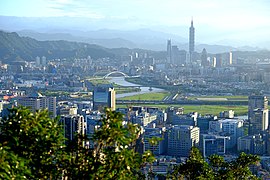
Taipei panoramic view
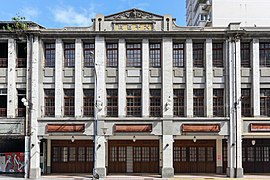
Twatutia
the main entrance of Chiang Kai-shek Memorial Hall

New year fireworks at Taipei 101

Presidential Office Building from Ketagalan Boulevard
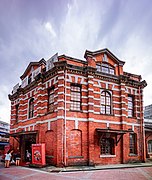
Red House Theater
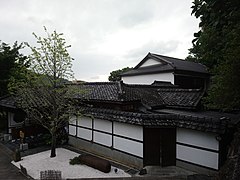
Beitou Museum

Grand Hotel Taipei
Dazhi Bridge
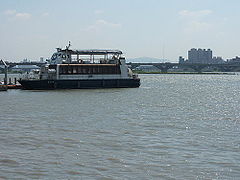
Dadaocheng Wharf, Taipei
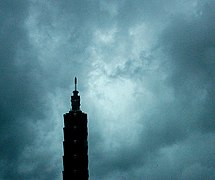
A typhoon makes landfall in Taipei City

Zhishan Garden at the National Palace Museum

Ximending at night

Taipei Story House (Yuanshan Mansion)
Daan Park

Daan Park
See also[]
- Taipei-Keelung Metropolitan Area
- List of districts of Taipei by area
- List of districts of Taipei by population
- List of districts of Taipei by population density
- List of most expensive cities for expatriate employees (#61 in the world)
- List of schools in Taipei
- Taipei Community Services Center (offers support services to the international community)
- American Institute in Taiwan
Notes[]
Words in native languages[]
References[]
- ^ 《中華民國統計資訊網》縣市重要統計指標查詢系統網 (in Chinese). Archived from the original on 12 June 2016. Retrieved 13 June 2016.
- ^ "Demographia World Urban Areas PDF" (PDF). Demographia. April 2016. Archived (PDF) from the original on 3 May 2018. Retrieved 6 June 2016.
- ^ "Demographia World Urban Areas PDF" (PDF). Demographia. Archived (PDF) from the original on 3 May 2018. Retrieved 30 November 2019.
- ^ "Taipei" Archived 8 December 2017 at the Wayback Machine. Random House Webster's Unabridged Dictionary.
- ^ Jump up to: a b "Taipei City Government: Home – I. Geographic Overview". Taipei City Government. 23 October 2006. Archived from the original on 9 December 2013. Retrieved 4 August 2009.
- ^ Jump up to: a b c d 鄉鎮市區人口及按都會區統計. Taiwan Ministry of Interior. December 2015. Archived from the original on 9 December 2013. Retrieved 11 December 2016.
- ^ "Methods and Term Definitions". Directorate General of Budget, Accounting and Statistics. Archived from the original on 12 December 2018. Retrieved 4 August 2009.
- ^ "The World According to GaWC 2020". GaWC - Research Network. Globalization and World Cities. Retrieved 26 August 2020.
- ^ "Taiwan tech industry faces up to South Korea's Samsung". The Seattle Times. April 2013. Archived from the original on 25 August 2017. Retrieved 25 August 2017.
- ^ Skinner, G. William (1973). Modern Chinese society:an analytical bibliography. Stanford University Press. p. 55. ISBN 0-8047-0753-7.
- ^ "Taiwan place names". Pīnyīn.info (in Chinese and English). Retrieved 15 September 2020.
鄉鎮市區別 Hanyu Pinyin (recommended) Hanyu Pinyin (with tones) Tongyong Pinyin old forms
...
台北市 Taibei Táiběi Taibei Taipei - ^ Eryk Smith (27 November 2017). "OPINION: Hanyu Pinyin Should Not Be Political, Kaohsiung". Retrieved 15 September 2020.
The capital will not see its name re-christened "Taibei" anytime soon and that's fine
- ^ Elana Shohamy, Durk Gorter, ed. (2009). Linguistic Landscape: Expanding the Scenery. Routledge. p. [1]. ISBN 978-0-203-93096-0.
However, I do use the commonly rendered "Taipei," instead of "Taibei" (Táiběi).
- ^ William Campbell (1915). Sketches from Formosa. p. 82 – via Internet Archive.
No sooner had the Governor-General at Tai-pak received telegraphic information of the magnitude of the calamity, than instruction were issued for a large company of surgeons, nurses, and assistants to proceed at once to Ka-gi.
- ^ "Tai-pak". The Free Dictionary. Archived from the original on 13 September 2015. Retrieved 23 November 2019.
Taipei (redirected from Tai-pak)
- ^ Alice Ballantine Kirjassoff (March 1920). "FORMOSA THE BEAUTIFUL". National Geographic Magazine. Vol. 37 no. 3. pp. 257, 262.
I boarded a train for Taihoku, the capital city, which on most maps still bears its old Chinese name of Taipeh.{...}Taihoku (Taipeh)
- ^ "Taipeh". The Free Dictionary. Archived from the original on 27 October 2019. Retrieved 23 November 2019.
Noun 1. Taipeh - the capital of Nationalist ChinaTaipeh - the capital of Nationalist China; located in northern Taiwan
- ^ "Taipei's History and Development". Taipei City Government. November 2014. Archived from the original on 30 December 2014. Retrieved 15 January 2015.
- ^ "Taipei (Taiwan) :: History". Britannica.com. Archived from the original on 27 May 2010. Retrieved 4 July 2010.
- ^ Davidson, James W. (1903). The Island of Formosa, Past and Present : history, people, resources, and commercial prospects : tea, camphor, sugar, gold, coal, sulphur, economical plants, and other productions. London and New York: Macmillan & Co. p. 245. OL 6931635M. Archived from the original on 8 January 2015. Retrieved 10 January 2015.
- ^ Jump up to: a b c Marsh, Robert (1996). The Great Transformation. M. E. Sharpe. p. 84. ISBN 1-56324-788-7.
- ^ Jump up to: a b Ng, Franklin (1998). The Taiwanese Americans. Greenwood Publishing Group. p. 10. ISBN 0-313-29762-2.
- ^ Jump up to: a b "Taiwan Timeline – Retreat to Taiwan". BBC News. 2000. Archived from the original on 24 June 2009. Retrieved 13 July 2009. Taipei has never been declared the official capital but Kuomintang loyalists today generally regard it as such. In 2004 elementary textbook references stating "Nanjing is the capital of the Republic of China" were replaced with "Taipei is the location of the central government of the Republic of China."
- ^ D. E. H. Russell (1974). Rebellion, Revolution, and Armed Force. Academic Press. p. 111. ISBN 0-13-785745-4.
On Dec. 8, 1949, T'ai-pei, on the island of Formosa, to which Chiang Kai-shek and many of his followers had fled, was declared the Nationalist Capital.
- ^ "History". Taipei City Government. 29 March 2004. Archived from the original on 7 May 2005. Retrieved 11 August 2009.
- ^ Kelly, Robert (2007). Taiwan. Lonely Planet Publications. p. 46. ISBN 978-1-74104-548-2.
- ^ Jump up to: a b c "History of Taipei". Taipei City Government. Archived from the original on 26 May 2007. Retrieved 11 August 2009.
- ^ Allen, Joseph R. (2012). Taipei: City of Displacements. Seattle: University of Washington Press. pp. 75–81. ISBN 978-0-295-80426-2.
- ^ Jump up to: a b Marsh (1996), p. 85.
- ^ Republic of China Yearbook. Kwang Hwa Publishing Co. 2002. p. 120. ISBN 957-9227-35-7.
- ^ "About Taipei – Taipei Profile". Department of Information and Tourism, Taipei City Government. Archived from the original on 20 December 2016. Retrieved 12 December 2016.
- ^ "Geographical Overview". english.gov.taipei. Archived from the original on 20 December 2016. Retrieved 12 December 2016.
- ^ Jump up to: a b "Geography/Population". Taipei City Government. 29 March 2004. Archived from the original on 27 January 2005. Retrieved 11 August 2009.
- ^ Taipei City Archived 2 April 2013 at the Wayback Machine - Academia Sinica
- ^ Living in Taipei Archived 17 February 2012 at the Wayback Machine - Mandarin Training Center, a subsidiary of National Taiwan Normal University
- ^ Taipei, Taiwan; the sister city of Los Angeles Archived 20 January 2013 at the Wayback Machine - Los Angeles City Council
- ^ "Köppen−Geiger Climate Classification". Archived from the original on 6 September 2010.
- ^ "Weather History for Sungshan, Taiwan". Wunderground. Archived from the original on 5 May 2015. Retrieved 29 June 2014.
- ^ "Monthly Mean". Central Weather Bureau. Retrieved 19 January 2021.
- ^ "Pollution is a major threat for Asian cities, says new report". EarthTimes. 14 December 2006. Archived from the original on 18 September 2012. Retrieved 22 July 2010.
- ^ Oung, Angelica (4 May 2007). "Taipei air pollution alarming: scientists". The Taipei Times. Archived from the original on 5 July 2009. Retrieved 27 July 2009.
- ^ Jump up to: a b c d e f "Demographical Overview". Taipei City Government. 28 July 2009. Archived from the original on 15 July 2010. Retrieved 11 July 2010.
- ^ "Premier agrees to suspend sales of state-owned prime city land". Central News Agency. 2 March 2010. Archived from the original on 16 September 2011. Retrieved 11 July 2010.
- ^ "Taiwan's elderly population reaches one in 10: interior ministry". Central News Agency. 23 January 2010. Archived from the original on 1 December 2011. Retrieved 11 July 2010.
- ^ https://www-ws.gov.taipei/001/Upload/367/relfile/48245/8011536/8eb64793-117b-4166-8b27-bb674f5e2f98.pdf
- ^ Kwok, R. Yin-Wang (2005). Globalizing Taipei: the political economy of spatial development. Routledge. p. 163. ISBN 0-415-35451-X.
- ^ "National Statistics, Republic of China – Latest Indicators". Directorate General of Budget, Accounting and Statistics. Archived from the original on 27 April 2011. Retrieved 15 March 2010.
- ^ Parilla, Alan Berube, Jesus Leal Trujillo, Tao Ran, and Joseph (22 January 2015). "Global Metro Monitor". Brookings. Archived from the original on 25 May 2017. Retrieved 18 July 2018.
- ^ "Archived copy". Archived from the original on 22 December 2015. Retrieved 20 December 2015.CS1 maint: archived copy as title (link)
- ^ "Archived copy". Archived from the original on 13 January 2018. Retrieved 13 January 2018.CS1 maint: archived copy as title (link)
- ^ "Archived copy". Archived from the original on 19 December 2015. Retrieved 20 December 2015.CS1 maint: archived copy as title (link)
- ^ admin@hurun.net. "Hurun Report - Details". www.hurun.net. Archived from the original on 3 March 2018. Retrieved 18 July 2018.
- ^ "The 25 most high-tech cities in the world". Business Insider. Archived from the original on 18 July 2018. Retrieved 18 July 2018.
- ^ "IESE Cities in Motion Index 2017 | Cities in Motion". blog.iese.edu. Archived from the original on 18 July 2018. Retrieved 18 July 2018.
- ^ "Fortune Global 500 List 2017: See Who Made It". Fortune. Archived from the original on 18 July 2018. Retrieved 18 July 2018.
- ^ "ITO Invest Taipei". invest.taipei. Archived from the original on 18 July 2018. Retrieved 18 July 2018.
- ^ Jennings, Ralph. "Why Google, IBM & Microsoft Are All Expanding in Taiwan This Year". Forbes. Archived from the original on 18 July 2018. Retrieved 18 July 2018.
- ^ "Google expands in Taiwan, its top Asian R&D hub". Nikkei Asian Review. Archived from the original on 18 July 2018. Retrieved 18 July 2018.
- ^ "ITO Invest Taipei". invest.taipei. Archived from the original on 18 July 2018. Retrieved 18 July 2018.
- ^ "Taiwan Startups". AngelList. Archived from the original on 27 February 2017. Retrieved 18 July 2018.
- ^ "I just downloaded the GSER 2018 by @startupgenome". startupgenome.com. Retrieved 18 July 2018.[permanent dead link]
- ^ 歷年觀光外匯收入統計. Tourism Bureau, Ministry of Transportation and Communication. Archived from the original on 21 July 2011. Retrieved 24 January 2010.
- ^ 97年臺閩地區主要觀光遊憩區遊客人次月別統計. Tourism Bureau, Ministry of Transportation and Communication. Archived from the original on 21 July 2011. Retrieved 24 January 2010.
- ^ "Euromonitor International's Top City Destination Ranking". 20 January 2010. Archived from the original on 5 March 2011. Retrieved 26 January 2010.
- ^ "Taiwan's tourism revenue on the rise: survey". Focus Taiwan News Channel. 14 July 2010. Archived from the original on 25 July 2011. Retrieved 15 July 2010.
- ^ "2014 Global Destination Cities Index" (PDF). MasterCard. Archived (PDF) from the original on 16 September 2018. Retrieved 10 July 2014.
- ^ "Taipei makes list of world's top 15 tourist destinations: survey". Focus Taiwan News Channel. 9 July 2014. Archived from the original on 14 July 2014. Retrieved 10 July 2014.
- ^ "National Chiang Kai-shek Memorial Hall". 5 May 2009. Archived from the original on 8 April 2009. Retrieved 9 August 2009.
- ^ Jump up to: a b "National Taiwan Museum: History". National Taiwan Museum. Archived from the original on 22 April 2008. Retrieved 9 August 2009.
- ^ "Taipei's National Palace Museum". BBC. Archived from the original on 12 November 2012. Retrieved 4 June 2008.
- ^ Jump up to: a b Nystedt, Dan (3 June 2007). "Ancient China's treasures go digital". Washington Post. Archived from the original on 21 July 2013. Retrieved 9 August 2009.
- ^ "The History of memorial hall". National Dr. Sun Yat-sen Memorial Hall. Archived from the original on 9 April 2015. Retrieved 16 December 2016.
- ^ "From History to Contemporary". Museum of Contemporary Art Taipei. Archived from the original on 23 February 2009. Retrieved 9 August 2009.
- ^ Basulto, David (12 February 2012). "OMA's Taipei Performing Arts Center breaks ground". ArchDaily. Retrieved 9 August 2012.
- ^ Reid, Robert (June 2011). "Taipei Performing Arts Center will feature seismic isolators and projecting auditoriums". Civil Engineering: 14–16.
- ^ "Taipei Performing Arts Center promises to become world-class architecture". Taiwan News. 8 November 2009. Archived from the original on 4 June 2011. Retrieved 22 July 2010.
- ^ "Winning designs for Taipei Performing Arts Center on display". Central News Agency. 21 March 2009. Archived from the original on 1 December 2011. Retrieved 22 July 2010.
- ^ "Taipei invites architects | Taipei Times, 2008.07.25". Taipeitimes.com. 25 July 2008. Archived from the original on 23 September 2009. Retrieved 4 July 2010.
- ^ Kelly (2007), p. 99.
- ^ Iwabuchi, Kōichi (2004). Feeling Asian modernities: transnational consumption of Japanese TV dramas. Hong Kong University Press. p. 111. ISBN 962-209-632-8.
- ^ "Longshan Temple, Baoan Temple, and Xiahai City God Temple: Taipei's Glorious Heritage-Site Temples". Department of Information Technology. 29 January 2009. Archived from the original on 29 June 2011. Retrieved 22 July 2010.
- ^ "Taipei Confucius Temple". Datong District Office, Taipei City. 26 May 2010. Archived from the original on 15 August 2011. Retrieved 22 July 2010.
- ^ "Transformation of "Liugong Canal" – Looking Back on Xinsheng South Road". Department of Rapid Transit Systems. 1 October 2008. Archived from the original on 12 September 2011. Retrieved 22 July 2010.
- ^ "About Daan District". Taipei City Government. Archived from the original on 14 September 2012. Retrieved 22 July 2010.
- ^ "About Taipei 5: Religions – Wikimania 2007, The International Wikimedia Conference". Wikimania2007.wikimedia.org. 26 July 2007. Archived from the original on 27 December 2008. Retrieved 27 July 2009.
- ^ Jump up to: a b "Chapter 19 Tourism". Republic of China Yearbook 2008. ROC Government Information Office. Archived from the original on 5 November 2009. Retrieved 14 July 2009.
- ^ "Your Favorite Ebook Site -". english.2009deaflympics.org. Archived from the original on 4 June 2013. Retrieved 26 July 2017.
- ^ Kwok, R. Yin-Wang (2005). Globalizing Taipei. Routledge. p. 201. ISBN 0-415-35451-X.
- ^ Bradsher, Keith (10 December 2006). "Taiwan Leader's Party Wins in Mayoral Vote, but Recount Is Sought". The New York Times. Archived from the original on 7 March 2012. Retrieved 14 July 2009.
- ^ Loa, Iok-sin; Ting, Wei-chieh; Chung, Jake (26 December 2014). "New mayors, commissioners sworn in". Taipei Times. Archived from the original on 20 December 2016. Retrieved 19 December 2016.
- ^ "Elections 2006: Election results a headache for Ma". Taipei Times. 10 December 2006. Archived from the original on 24 July 2008. Retrieved 10 August 2009.
- ^ "KMT wins two-thirds majority". Taipei Times. 13 January 2008. Archived from the original on 24 July 2008. Retrieved 10 August 2009.
- ^ "Rain dampens enthusiasm for protest". Taipei Times. 11 September 2006. Archived from the original on 27 July 2008. Retrieved 10 August 2009.
- ^ "Pro-localization groups stage rally on Ma's 100th day". Taipei Times. 30 August 2008. Archived from the original on 8 September 2008. Retrieved 10 August 2009.
- ^ "Clear Ketagalan ahead of Double Ten, Wang urges". Taipei Times. 6 September 2006. Archived from the original on 21 September 2011. Retrieved 10 August 2009.
- ^ "Taiwan Garbage Trucks: Classical Music Accompanies Collection (VIDEO)". Huffington Post. 9 January 2012. Archived from the original on 5 October 2017. Retrieved 8 June 2018.
- ^ "Recycling: Taiwan's Way of Life". Taiwan Review. 1 March 2010. Archived from the original on 6 December 2010. Retrieved 31 August 2010.
- ^ "Administrative Districts". Taipei City Government. Archived from the original on 15 July 2010. Retrieved 11 July 2010.
- ^ "Administrative Districts". Taipei City Government. Archived from the original on 27 March 2019. Retrieved 22 June 2019.
There are 12 administrative districts in the Taipei City, including Songshan, Xinyi, Daan, Zhongshan, Zhongzheng, Datong, Wanhua,Wenshan, Nangang, Neihu, Shilin, and Beitou
- ^ 臺北行政區 [Taipei Administrative Divisions] (in Chinese). 臺北市政府全球資訊網. 20 February 2019. Retrieved 30 March 2019.
現劃分12行政區,{...}北投區公所 士林區公所 中山區公所 內湖區公所 大同區公所 松山區公所 萬華區公所 中正區公所 大安區公所 信義區公所 南港區公所 文山區公所
- ^ Jump up to: a b Jones, Ian (2008). City Museums and City Development. Rowman & Littlefield. p. 102. ISBN 978-0-7591-1180-6.
- ^ "Only 13% using Taiwan's public transport". The China Post/Asia News Network. 6 February 2010. Archived from the original on 27 September 2011. Retrieved 8 February 2010.
- ^ Jump up to: a b "Taipei City Today". Taipei City Government. 17 August 2004. Archived from the original on 4 November 2013. Retrieved 11 August 2009.
- ^ "Metro Tickets". Taipei Rapid Transit Corporation. Archived from the original on 22 August 2008. Retrieved 14 July 2009.
- ^ "Hitachi Rail Commissions Phase 1 of Taipei Metro Circular Line". Railway-News. 3 February 2020. Archived from the original on 1 March 2020. Retrieved 3 March 2020.
- ^ "Free rides on MRT Circular Line to end Saturday - Focus Taiwan". focustaiwan.tw (in Chinese). Archived from the original on 3 March 2020. Retrieved 3 March 2020.
- ^ "Taipei Main Station Project". Railway Reconstruction Bureau, Ministry of Transportation and Communications. Archived from the original on 9 December 2013. Retrieved 23 February 2011.
- ^ "CHAPTER 13 Transportation and Telecommunications". Republic of China Yearbook 2008. ROC Government Information Office. Archived from the original on 13 December 2009. Retrieved 14 July 2009.
- ^ "Traffic chaos expected in Xinyi". Taipei Times. 24 May 2010. Archived from the original on 1 December 2011. Retrieved 11 July 2010.
- ^ "National Taiwan University – About NTU". 6 August 2007. Retrieved 27 July 2009.[permanent dead link]
- ^ "起點 時代步履中奮力前行". 台北馬拉松 Taipei Marathon. Taipei Marathon. Retrieved 20 October 2019.
- ^ "Route Map". www.taipeicitymarathon.com/en/ROUTEMAP.php. Taipei Marathon. Retrieved 20 October 2019.
- ^ https://web.archive.org/web/20200902131643/https://www.worldathletics.org/competitions/world-athletics-label-road-races/calendar/2020
- ^ 又來了 小巨蛋沒有LED計分器. China Times (in Chinese). 14 March 2007. Archived from the original on 18 March 2007.
- ^ "Mayday keeps promise by staging online concert in May 五月天遵守「五月之約」 線上全球開唱 - Taipei Times". Https. 5 June 2020. Retrieved 12 December 2020.
- ^ 台北聽奧主場館 明正式啟用. Liberty Times (in Chinese). 22 July 2009. Archived from the original on 15 June 2012. Retrieved 5 December 2018.
- ^ "Construction of Taipei Dome to be completed by end of 2021". Taiwan News. Central News Agency. 9 August 2020. Retrieved 30 December 2020.
- ^ "Taiwan wins Junior League World Series". Ministry of Foreign Affairs, Republic of China (Taiwan). Taiwan Today. 23 August 2010. Archived from the original on 24 February 2019. Retrieved 24 February 2019.
- ^ "Little League Baseball". www.littleleague.org. Archived from the original on 17 October 2007. Retrieved 26 July 2017.
- ^ Taipei Sister city list Archived 10 April 2014 at the Wayback Machine Taipei City Council
- ^ Jump up to: a b c d e "Taipei City Council". Archived from the original on 23 October 2016. Retrieved 20 October 2016.
- ^ The city is no longer listed as a sister city in either city's websites: [2] Archived 23 October 2016 at the Wayback Machine[3] Archived 6 February 2015 at the Wayback Machine
- ^ "Sister Cities". The Local Government of Quezon City. Archived from the original on 1 October 2017. Retrieved 9 April 2019.
- ^ "International Cooperation: Sister Cities". Seoul Metropolitan Government. seoul.go.kr. Archived from the original on 10 December 2007. Retrieved 26 January 2008.
- ^ "Seoul -Sister Cities [via WayBackMachine]". Seoul Metropolitan Government (archived 2012-04-25). Archived from the original on 25 March 2012. Retrieved 23 August 2013.
- ^ "Sister Cities International (SCI)". Sister-cities.org. Archived from the original on 13 June 2015. Retrieved 21 April 2013.
- ^ "Phoenix Sister Cities". Phoenix Sister Cities. Archived from the original on 24 July 2013. Retrieved 6 August 2013.
- ^ "Miasta partnerskie Warszawy". um.warszawa.pl. Biuro Promocji Miasta. 4 May 2005. Archived from the original on 11 October 2007. Retrieved 29 August 2008.
- ^ "Sister Cities". Dallas-ecodev.org. Archived from the original on 28 May 2010. Retrieved 23 May 2010.
- ^ "Twin cities of Riga". Riga City Council. Archived from the original on 4 December 2008. Retrieved 27 July 2009.
- ^ "What's Behind the Prague-Taipei Sister City Ties?".
- ^ Mary Chin (5 May 2017). "City and cultural pacts with Taipei soon". Daily Express. Archived from the original on 5 May 2017. Retrieved 5 May 2017.
- ^ Scott E. Williams (2007). Hardcore History: The Extremely Unauthorized Story of ECW. Sports Publishing LLC. p. 65. ISBN 978-1-59670-021-5.
- ^ Garner, Dwight (4 June 2013). "A Literary Mind, Under the Spell of Drugs and a MacBook". The New York Times.
- ^ "High Resolution (2018) - IMDb".
Further reading[]
- Li, Jie; Xingjian Liu; Jianzheng Liu; Weifeng Li (June 2016). "City profile: Taipei". Cities. 55: 1–8. doi:10.1016/j.cities.2016.03.007.
External links[]
- Official website

- Taipei City Council
 Geographic data related to Taipei at OpenStreetMap
Geographic data related to Taipei at OpenStreetMap
- ^ Sarah Shair-Rosenfield (November 2020). "Taiwan combined" (PDF). The University of North Carolina at Chapel Hill. Retrieved 29 May 2021.
- Taipei
- Capitals in Asia
- Populated places established in 1884
- Municipalities of Taiwan
- 1884 establishments in China







